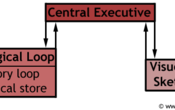Working Memory
Edited by Jamie (ScienceAid Editor), Taylor (ScienceAid Editor)
How Working Memory Works
Working memory is merely another name for short term memory It's given this name because it's function is far more complicated than a simple store, as was suggested in the multi-store model. Below we have a diagram which represents how this memory system is believed to work.
Central Executive
Relatively little is known about this part of the working memory, but it is thought to be the "boss", selectively attending to some stimuli whilst ignoring others and retrieving information for use by the working memory.
Phonological Loop
As you can see in the diagram, this system is made up of two components:
- 1The phonological store holds or stores information that is either speech or sound-related, however memory here lasts for a very short amount of time, only about two seconds. This component is also known as the inner ear.Phonological Store.Advertisement
- 2The articulatory loop (also articulatory control system), is a process for rehearsing the information and therefore keeping it in the loop. This part is know also as the inner voice. This is how a tune can get stuck in your head: it is continuously rehearsed by the 'inner voice', thus preventing it from leaving the working memory.Articulatory Loop.
Evidence for the existence of these two separate components is in a 1993 study by Paulesu et al:
| Aim | To investigate the nature of the phonological loop and working memory. |
| Method | Participants either stored a series of letters or mentally rehearsed the sounds of letters.
Whilst doing this, the blood flow in their brains was recorded using positron emission tomography (PET). |
| Results | They found that blood flow was quite different depending on the two types of task. |
| Conclusion | The results support the theory that the phonological loop has two different components: one for storage and one for rehearsal. |
Visuo Spatial Sketchpad
This component manipulates visual information. For example: imagine your bedroom and where the window is. It can also be called the 'inner eye' because it enables you to mentally see things without looking at them. Some research into it was done by one of the men who originally proposed the working memory: Alan Baddeley.
| Aim | To try and find evidence for a visuo-spatial sketchpad with a limited storage system. |
| Method | Participants tracked a moving spot of light.
At the same time they classified the angles in the letter 'F' virtually (i.e. a task that uses the visuo-spatial sketchpad as well. |
| Results | The participants found it very difficult to track the light and classify angles at the same time.
However it was far easier to track the light when given a verbal rather than visual task. |
| Conclusions | The tracking and imagining tasks were both competing for the limited resources of the visuo-spatial sketchpad so performance was impaired, however with the verbal task, the resources of the phonological loop were used. |
Evaluation
There is a final study that needs mentioning: Baddeley and Hitch (1976). They got participants to undertake reasoning tasks, thought to involve the central executive, while at the same time, performing another task, or nothing. They found that performance was impaired when making up random numbers, also involving the central executive. So in conclusion, working memory is a general executive system with a limited capacity for processing.
Working memory is concerned with not just storage (as the multi-store model is), but processing as well. On the downside, little is known about the central executive, and no precise details are available about it. This arguably hinders our understanding of the entire system, since the central executive is supposedly in the middle of all processing.
Referencing this Article
If you need to reference this article in your work, you can copy-paste the following depending on your required format:
APA (American Psychological Association)
Working Memory. (2017). In ScienceAid. Retrieved Apr 18, 2024, from https://scienceaid.net/psychology/cognition/working.html
MLA (Modern Language Association) "Working Memory." ScienceAid, scienceaid.net/psychology/cognition/working.html Accessed 18 Apr 2024.
Chicago / Turabian ScienceAid.net. "Working Memory." Accessed Apr 18, 2024. https://scienceaid.net/psychology/cognition/working.html.
If you have problems with any of the steps in this article, please ask a question for more help, or post in the comments section below.
Comments
Article Info
Categories : Cognition
Recent edits by: Jamie (ScienceAid Editor)




